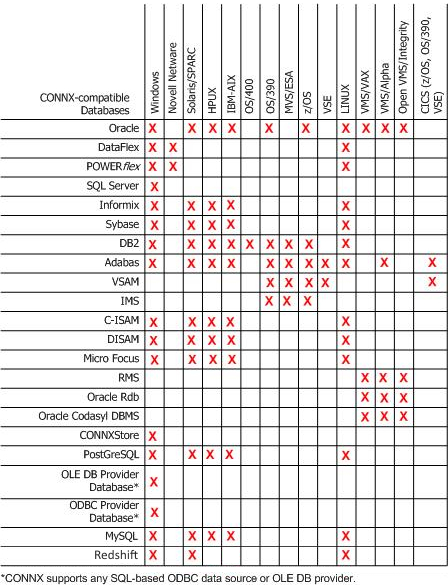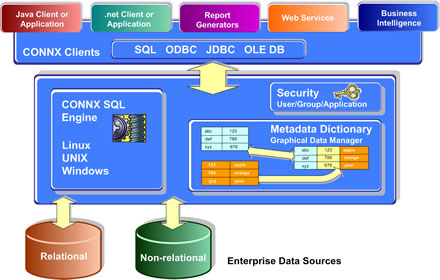CONNX is a universal data connectivity programming toolset that provides
real-time access to multiple disparate databases.
The table below illustrates the databases and relative operating systems
supported by CONNX. All of the databases shown can be accessed on Windows
and Unix client PCs.

With the CONNX product, data from any of the above database types can be retrieved and updated. The CONNX approach to data access is to present all of the different data sources as a single relational database. CONNX currently consists of seven main components: the CONNX Data Dictionary, the CONNX ODBC Driver, the CONNX OLE RPC Server, the CONNX Host Data Server (for RMS, Oracle Rdb, C-ISAM, VSAM, and DBMS), the CONNX JDBC Driver, the CONNX JDBC Server, and the CONNX JDBC Router.
CONNX
Architecture

CONNX has a distributed SQL engine, which means that the work of processing queries is distributed between the client and the server. Most of the CPU-intensive query processing, such as data conversion and sorting, is performed on the client computer. All of the data retrieval is performed on the server, although, in CONNX for DataFlex, all processing is done on the client computer.
The CONNX distribution of labor, except that for DataFlex, is shown in the following diagram:
CONNX Distribution of
Labor

This distributed architecture has several advantages:
When performing joins, significantly less data is sent across the network because no duplicates are transmitted.
The workload on the server is minimal, because CPU-bound tasks are moved to the client, resulting in a reduction of load on the mainframe.
When several users are issuing queries simultaneously, the CPU power of each client computer is utilized in addition to that of the server, resulting in true parallel processing. This makes CONNX highly scalable to a large enterprise.